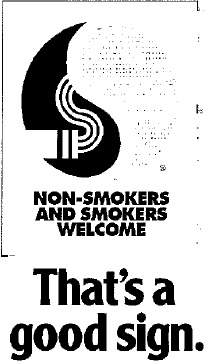Accommodation Program
|
This article is part of the Tobacco portal on Sourcewatch funded from 2006 - 2009 by the American Legacy Foundation. |
The Accommodation Program was started by Philip Morris in 1994 to advocate the use of separate smoking and non-smoking sections in public venues such as restaurants, hotels and bowling centers. PM rolled out its Accommodation Program in 1994 as a response to a proposed smoking ban in Pennsylvania, promoting it to the press and public as a "free customer service program" for hospitality venues to help them cope with conflicts caused by secondhand smoke in the workplace.[1]
PM promoted the Accommodation Program as a "reasonable" alternative to legislated smoking restrictions, but the Program also had a second, and perhaps more important function: it provided PM with an entree' into the hospitality industry, where it recruited hospitality business owners and associations to act as credible third party allies who assisted the company in fighting smoking restrictions. A internal PM report about the Accommodation Program describes the relationship:
The Accommodation Program serves as a link between PM and the hospitality industry. Our ability to interact effectively with the hospitality industry is critical to our ultimate objective, which is to maintain the ability for our consumers to enjoy our products in public venues such as restaurants, hotels, bowling centers, and shopping malls. This relationship becomes even more important as legislative threats continue to mount at local, state, and federal levels. [2]
PM provided restaurants that participated in its Accommodation Program with pre-paid signage and table-tents indicating their participation in the Program. The signs utilized a "ying-yang"-type symbol with a lit cigarette in one half, ostensibly promoting "harmony" between smokers and non-smokers. [3]
Through the personal visits, trade show appearances and presentations that promotion of its Accommodation Program afforded, PM convinced business owners in the hospitality sector that smoking restrictions cause deep and sustained financial losses, thus motivating hospitality businesses to help the company fight smoke-free laws and further promote the Accommodation program. PM also influenced many hospitality venues to invest in expensive ventilation systems, convincing them that ventilation is the best answer to problems caused secondhand smoke in the workplace (instead of policies ending smoking). To further promote the use of ventilation as an alternative to smoking bans, PM started a separate Ventilation Program in 1998.[4]
Another part of PM's Accommodation Program was its Airport Program, an effort to create and sustain smoking lounges in the major airports across the U.S. to help preserve the social acceptability of smoking and maintain cigarette sales.
Contents
Additional tobacco industry documents
SourceWatch Resources
- Tobacco industry
- Project Brass (A plan of action on the environmental tobacco smoke issue)
- INFOTAB ETS Project
- Secondary Smoke Advertisements
External Resources
- How Big Tobacco uses and abuses the restaurant industry (esp. sections on targeting restaurants with fake economics and ventilation hoax)
- The Accomodation Program 950000 Plan", a 1995 report on the progress and plans for the Accommodation Program
References
<tdo>search_term="Accommodation Program"</tdo>
- ↑ Philip Morris Press release March 14, 1995. 2 pp. Bates No. 2047874365/4366
- ↑ Philip Morris Philip Morris and the Hospitality Industry Report. 11 pp. June, 1995. Bates No. 2045517337/7347
- ↑ Connecticut Restaurant Association Entree Connecticut Premier Newsletter. 7 pp. January, 1995. Philip Morris Bates No. 2044324098/4104
- ↑ Philip Morris Ventilation Program Report. 1998. Bates NO. 2072264170

